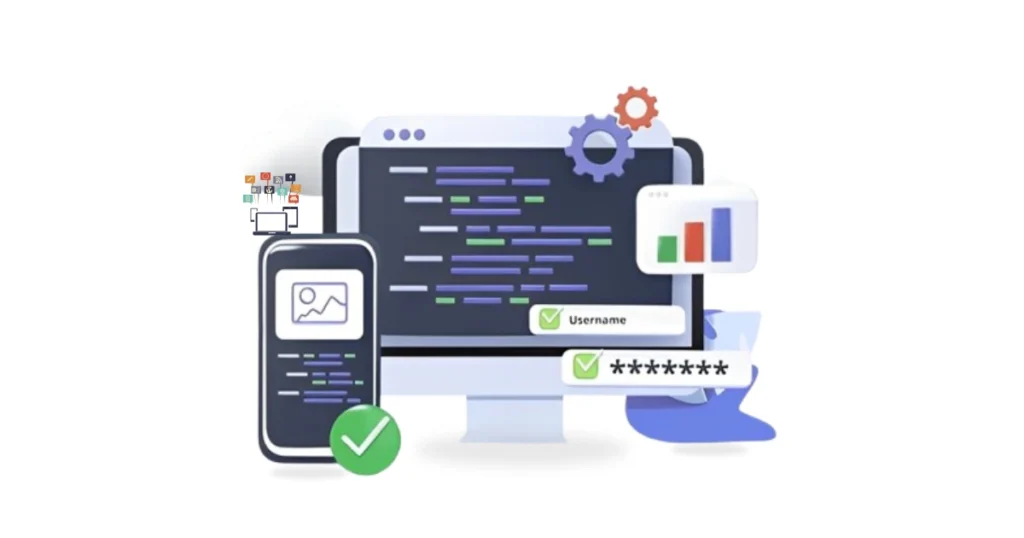Application deployment is referred to as the procedure of publishing a new version of the software or simply upgrading already existing applications into the production environment. The process could be application building, testing the application, and then its delivery to real users.

What is Application Deployment?
The last phase in the lifecycle of software development is the deployment of the application. The stage includes transferring parts of software products from a development environment to the environment where actual users will find these products for deployment. Application deployment is one complex process and tends to vary greatly with size, complexity of application, and choice of deployment strategy.
Key Components of Application Deployment
- Building: This is the process of converting source code into executable files or packages.
- Testing: Thorough testing is required so that the application is working and satisfies all requirements. This might include unit tests, integration tests, and user acceptance testing.
- Staging: Most often, staging mimics the production environment where an application has to be tested before its release to end-users.
- Release: This is the actual transfer of the application to the production environment. This may involve upgrading servers, databases, and other infrastructure components.
- Monitoring: Continuous monitoring is necessary to check the performance and stability of the deployed application. This helps identify any issues early, which may be solved rapidly.
How Application Deployment Benefits Enhancing Efficiency
- Agile Development: To deploy new features and updates into the market more rapidly, businesses can cut time-to-market, thereby getting a competitive advantage. Agile methodologies are influenced by the need for frequent and rapid deployments. The right deployment strategy helps Agile teams respond to the market and its subsequent changes by the customers more rapidly.
- Improved Quality: Automated deployment processes reduce human errors and enhance the overall quality of the software.
- Reduced downtime: The downtime is reduced by proper planning and execution as it causes minimal disruption to users.
- Increased Efficiency: Automated deployment tools and processes improve the efficiency of the deployment process by freeing developers from deploying software.
- Enhanced collaboration: Release processes enhance the collaboration of deployment between development, operations, and other teams engaged in the software development lifecycle.
What are the Application Deployment Process
The process of application deployment may be specific to an application and strategy for deployment, but generally includes the following process:
- Planning: It involves a description of what needs to be done during the scope of the deployment, identification of possible risks, and a very detailed plan on how to perform the deployment.
- Preparation: It involves getting ready for the deployment environment by installing software and preparing the servers.
- Deployment: This is transferring all the files regarding the application into the production environment, changing any current configuration setting necessary.
- Testing: This will occur after deployment to ensure the deployed application is working as expected in the production environment.
- Monitoring: The performance and stability of the application deployed have to be monitored continuously so that when some issues arise, they are easily handled.
The 5 Top Application Deployment Strategies
A variety of strategies exists for different kinds of deployments with their corresponding merits and drawbacks. Some common deployment strategies include:
- Big Bang Deployment: It’s the easiest of the applications to get deployed together as a unit. This deployment method is associated with the chances of huge amounts of downtime with an even higher chance of potential loss of data.
- Rolling updates: This process deploys an application to only a small percentage of servers and waits for deployment success. When it has gone through all successful deployments, gradually deploy to all other servers.
- Blue/Green Deployments: this is maintaining two identical production environments. After successfully rolling out the new version, it’s tested on a green environment and, subsequently, one switches traffic over from “blue” to “green”.
- Canary Deployment: This way of deployment consists of deploying a new version for a small proportion of users referred to as “canary.” In case everything goes well in the canary group, this roll-out is progressively made to other users.
- A/B Testing: This is an approach that provides developers with testing different versions of the application by using different subsets of users for comparison of one version against the other.
How to Choose the Right Deployment Strategy
The best deployment strategy for a specific application will be determined by many factors, which include the following:
- The size and complexity of the application
- The criticality of the application
- The level of acceptable risk
- The resources available
Various Application Deployment Tools
There are quite several tools that are available to automatically and streamline application deployment:
- Continuous integration/continuous delivery tools: They automate builds, tests, and deployments, therefore, allowing a fast and high-frequency deployment rate. Examples here include Jenkins CircleCI and GitLab CI/CD,
- Configuration Management Tools: These tools help to manage and automate the configuration of servers and other infrastructure components. Included in these are Ansible, Puppet, and Chef.
- Containerization Tools: Tools like Docker and Kubernetes enable the packaging and deployment of applications in isolated containers, making it easier to deploy and manage applications across different environments.
- Cloud Platforms: Many cloud platforms today, such as Amazon Web Services and Microsoft Azure to Google Cloud Platform, provide different tools and services for deploying and managing an application.
The 5 Best Practices for Application Deployment
- Automate as much as possible: Automate all those steps of the deployment process that could be automated in building, testing, and deployment.
- Use a staging environment: A staging environment that is a replica of the real environment is used for testing before it is run into production.
- Monitoring deployment: Monitor how the deployment process goes along and attend to any challenges that may surface as soon as they arise.
- Rollback plan: The rollback of the deployment is also planned for, in case some issues occur.
- Regularly review and improve: Continuously review and improve the deployment process for areas of improvement.
A2 Cloud Hosting: Empowering Seamless Application Deployment
A square Cloud Hosting enables a substantial improvement to your application deployment capabilities with the help of robust and scalable infrastructure. By providing a cloud services range that includes virtual servers, cloud servers, and managed services, A2 Cloud Hosting Services enables businesses to:
- Accelerate deployment: Deploy applications more quickly and with better efficiency by taking advantage of their high-performance infrastructure and advanced networking features.
- Enhance scalability: Scale up or down according to the fluctuating demands to ensure optimal performance at the time of as well as after deployment.
- Improve Reliability: Enjoy redundant infrastructure and robust security to ensure high availability and minimize downtime.
- Reduce Costs: Optimize resource utilization and leverage cost-effective pricing models to reduce overall IT infrastructure costs.
- Gain Flexibility: Choose from a variety of deployment options, including infrastructure as a service (IaaS), platform as a service (PaaS), and software as a service (SaaS), to best suit your specific needs.
By collaborating with A2 Cloud Hosting, companies will be able to simplify their application deployment process, minimize operational overheads, and deliver innovative applications to their customers.
Conclusion
In this intensely competitive digital world, speed and efficiency of application deployment are no longer differentiators but determinants of success. An organization has a significant advantage with mastery over the deployment of applications quickly and reliably.
It enables them to respond to market shifts; deliver new features to customers faster; and, therefore, better maintain their competitive advantage. It has turned out to be a strategic imperative rather than merely a technical exercise. Organizations have much to gain by embracing automation, robust testing methodologies, and well-defined deployment strategies.
Accelerated time-to-market, improved software quality, reduced operational costs, and enhanced customer satisfaction are some of the benefits that can be obtained. If you need professional advice, contact our DevOps Engineers at +1(800) 217-0394 or chat with our live expert through the Chat-box for best cloud and hosting services.
FAQs
What are the biggest pain points of deploying applications today?
Ans. There are many challenges to modern application deployment. Modern applications, especially those based on microservices architecture and containerization, add intractable dependencies that can make it hard to deploy them. With a requirement for faster and more frequent releases, robust and automated deployment pipelines need to be designed to prevent bottlenecks. Security of the application and the process of deployment requires proper security throughout. Deployments often cause interruption of services affecting the user experience as well as the business operations thus high availability, and low downtime deployment. Lastly, complexity in the infrastructure, like in cloud or hybrid environments, necessitates agile management and orchestration for efficient deployment.
What are the ways an organization can secure its application deployment pipeline?
Ans. To secure their deployment pipeline, organizations must employ strong access controls that deny unauthorized access to sensitive environments and data based on the principle of least privilege. In addition, protecting sensitive data at rest and during transit with robust encryption is essential. Organizations should have regular security audits and penetration testing for identification and addressing vulnerabilities. Security checks of the CI/CD pipeline may be integrated and, for instance, automated security scanning and testing conducted at different steps in the release process. Update the latest on security best practices and industry standards because this is really what will respond to emerging threats and deploy in a secure environment.
How can organizations measure the success of their application deployment process?
Ans. Organizations can measure the success of their application deployment process by tracking key metrics. These include deployment frequency, which indicates how often applications are deployed to production. Deployment lead time measures the duration it takes to deploy a change to production. The change failure rate indicates how often deployments fail. Mean time to recover (MTTR) is how long it takes to resolve incidents after deployment. In addition, the satisfaction of the customers gives quality and reliability to the deployed application. By following these metrics, organizations can trace the areas that need improvement to continuously optimize the deployment process.

Brown Lopez is a Cloud Engineer and technical writer based in Austin, USA, who enjoys turning complex cloud ideas into clear, simple insights. With solid experience in cloud architecture and real-world projects, he loves creating practical content that helps professionals understand, build, and improve their cloud solutions with confidence.